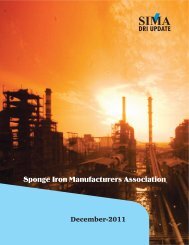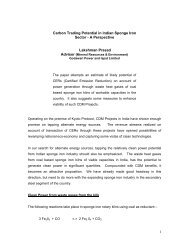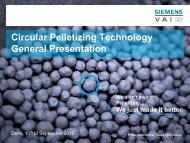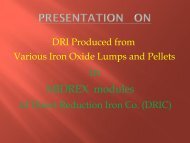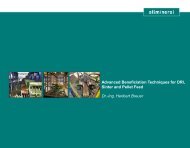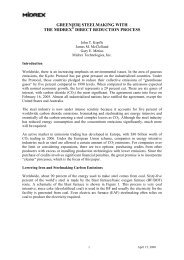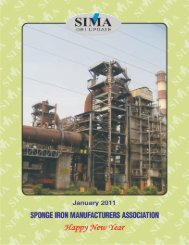You also want an ePaper? Increase the reach of your titles
YUMPU automatically turns print PDFs into web optimized ePapers that Google loves.
Introduction<br />
SOLUTIONS FOR INDIAN STEELMAKERS<br />
FROM MIDREX TECHNOLOGIES, INC.<br />
AND SASOL-LURGI TECHNOLOGY COMPANY (PTY) LTD<br />
By:<br />
Robert Cheeley, Sales Manager<br />
John Kopfle, Director – Corporate Development<br />
Dr. Jayson Ripke, Plant Sales Manager<br />
Midrex Technologies, Inc.<br />
Irek Wanicki, Lead Process Engineer<br />
Pauli Baumann, Licensing Manager<br />
Sasol-Lurgi Technology Company (Pty) Ltd<br />
As one of the world’s most vibrant and growing<br />
economies, India has a strong steel demand for<br />
infrastructure, construction, and consumer goods.<br />
Its steel demand is growing at seven percent per<br />
year. To feed this demand, steel production has<br />
grown from less than 10 million tons (Mt) in 1980 to<br />
over 44 Mt in 2006, as shown in Figure 1.<br />
Figure 1<br />
India Steel and DRI Production<br />
Sources: IISI and Midrex Technologies<br />
There are ambitious plans to increase the country’s<br />
steel production, with the Indian government having<br />
set a goal of 110 Mt by 2020.<br />
Approximately 45 percent of the India’s steel is<br />
currently produced in electric furnaces. Given the<br />
lack of domestic scrap and the good availability of<br />
natural resources like iron ore, coal and natural gas,<br />
direct reduction has provided much of the iron units<br />
required for Electric Arc Furnace (EAF) steel<br />
production growth. Direct Reduced Iron (DRI)<br />
production has increased tremendously since 1980,<br />
from essentially zero to over 15 Mt in 2006, as shown<br />
in Figure 1. Of the total DRI production in 2006, 68<br />
percent was produced from coal and 32 percent from<br />
natural gas. India is now the world’s largest producer<br />
of DRI.<br />
There are two primary means of DRI production in<br />
India: small-scale rotary kilns using local coal and<br />
iron ore lump, and large-scale shaft furnace plants<br />
using natural gas and iron oxide pellets and lump.<br />
In recent years, almost all the growth in DRI<br />
production has been due to the installation of rotary<br />
kiln facilities and there are now over 350 of these<br />
plants. Many are small-scale and it is believed that<br />
over 100 have capacities from 10,000-20,000 tpy.<br />
There are only seven natural gas-fired shaft furnace<br />
plants (including six MIDREX® Modules), but they<br />
produce nearly half as much DRI as all the rotary<br />
kilns combined.<br />
Technologies for Growth<br />
For India to grow its steel production significantly,<br />
what are the options? Direct reduction using coalfired<br />
rotary kilns or natural gas-fired shaft furnaces<br />
are logical choices. Rotary kiln DRI has been<br />
installed because it makes use of domestic iron ore<br />
MAY-<strong>2007</strong>/2



